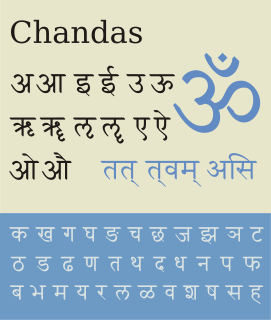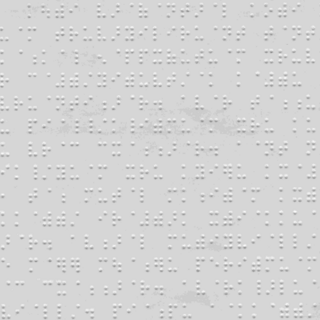It is proposed that this article be deleted because of the following concern:
If you can address this concern by improving, copyediting, sourcing, renaming, or merging the page, please edit this page and do so. You may remove this message if you improve the article or otherwise object to deletion for any reason. Although not required, you are encouraged to explain why you object to the deletion, either in your edit summary or on the talk page. If this template is removed, do not replace it . The article may be deleted if this message remains in place for seven days, i.e., after 20:01, 24 April 2021 (UTC). Nominator: Please consider notifying the author/project: {{ subst:proposed deletion notify |Nayanagari|concern=Unsourced stub, fails [[WP:NOTE]], a self-promotion by the author of the paper linked under External links.}} ~~~~ |
Nayanagari is a conjunct free writing style for the Devanagari script. The Nayanagari alphabet set consists of only 8 vowels and 37 consonants. There are only a total of 45 characters in Nayanagari, and its use in computer and other applications are very simple and effective.
The Nayanagari vowels are always used in a progressive manner, while always being considered as a full independent alphabet. The Nayanagari consonants are all phonemic, as opposed to syllabic consonants of Devanagari, or of other Brahmi scripts.

An alphabet is a standardized set of basic written symbols or graphemes that represent the phonemes of certain spoken languages. Not all writing systems represent language in this way; in a syllabary, each character represents a syllable, for instance, and logographic systems use characters to represent words, morphemes, or other semantic units.
An abjad is a type of writing system in which each symbol or glyph stands for a consonant, in effect leaving it to readers to infer or otherwise supply an appropriate vowel. The term is a neologism introduced in 1990 by Peter T. Daniels. Other terms for the same concept include: partial phonemic script, segmentally linear defective phonographic script, consonantary, consonant writing and consonantal alphabet.

An abugida, sometimes known as alphasyllabary, neosyllabary or pseudo-alphabet, is a segmental writing system in which consonant-vowel sequences are written as a unit; each unit is based on a consonant letter, and vowel notation is secondary. This contrasts with a full alphabet, in which vowels have status equal to consonants, and with an abjad, in which vowel marking is absent, partial, or optional. The terms also contrast them with a syllabary, in which the symbols cannot be split into separate consonants and vowels.

Devanagari, also called Nagari, is a left-to-right abugida (alphasyllabary), based on the ancient Brāhmī script, used in the Indian subcontinent. It was developed in ancient India from the 1st to the 4th century CE and was in regular use by the 7th century CE. The Devanagari script, composed of 47 primary characters including 14 vowels and 33 consonants, is the fourth most widely adopted writing system in the world, being used for over 120 languages.

Sinhala script, also known as Sinhalese script, is a writing system used by the Sinhalese people and most Sri Lankans in Sri Lanka and elsewhere to write the Sinhala language, as well as the liturgical languages, Pali and Sanskrit. The Sinhalese Akṣara Mālāva, one of the Brahmic scripts, is a descendant of the Ancient Indian Brahmi script.

The Brahmic scripts, also known as Indic scripts, are a family of abugida writing systems. They are used throughout the Indian subcontinent, Southeast Asia and parts of East Asia, including Japan in the form of Siddhaṃ. They have descended from the Brahmi script of ancient India and are used by various languages in several language families in South, East and Southeast Asia: Indo-Aryan, Dravidian, Tibeto-Burman, Mongolic, Austroasiatic, Austronesian and Tai. They were also the source of the dictionary order (gojūon) of Japanese kana.
The Thai script is the abugida used to write Thai, Southern Thai and many other languages spoken in Thailand. The Thai alphabet itself has 44 consonant symbols, 16 vowel symbols that combine into at least 32 vowel forms and four tone diacritics to create characters mostly representing syllables.

The Soyombo script is an abugida developed by the monk and scholar Zanabazar in 1686 to write Mongolian. It can also be used to write Tibetan and Sanskrit.
Warang Citi is a writing system invented by Lako Bodra for the Ho language spoken in East India. It is used in primary and adult education and in various publications.
Hindustani has been written in several different scripts. Most Hindi texts are written in the Devanagari script, which is derived from the Brāhmī script of Ancient India. Most Urdu texts are written in the Urdu alphabet, which comes from the Persian alphabet. Hindustani has been written in both scripts. In recent years, the Latin script has been used in these languages for technological or internationalization reasons. Historically, Kaithi script has also been used.
Mal Paharia is a language spoken by 51,000 of 110,000 ethnic Mal Paharia in the states of Jharkhand and West Bengal in India, and regions of Bangladesh. The language is also known as Mal Pahoria, Malto, Malti, Paharia, Parsi, and Mal Pahariya. It has been variously regarded as a Bengali–Assamese language, a dialect of Malto, and a mixed Dravidian–Indo-Aryan language. There is a generally positive attitude among speakers of the language towards it, but it is considered vulnerable as some speakers have shifted to Bengali. Mal Paharia uses the Devanagari script and rules for its writing/ reading/ speech.

Modi is a script used to write the Marathi language, which is the primary language spoken in the state of Maharashtra, India. There are multiple theories concerning its origin. The Modi script was used alongside the Devanagari script to write Marathi until the 20th century when the Balbodh style of the Devanagari script was promoted as the standard writing system for Marathi.

Bharati braille, or Bharatiya Braille, is a largely unified braille script for writing the languages of India. When India gained independence, eleven braille scripts were in use, in different parts of the country and for different languages. By 1951, a single national standard had been settled on, Bharati braille, which has since been adopted by Sri Lanka, Nepal, and Bangladesh. There are slight differences in the orthographies for Nepali in India and Nepal, and for Tamil in India and Sri Lanka. There are significant differences in Bengali Braille between India and Bangladesh, with several letters differing. Pakistan has not adopted Bharati braille, so the Urdu Braille of Pakistan is an entirely different alphabet than the Urdu Braille of India, with their commonalities largely due to their common inheritance from English or International Braille. Sinhala Braille largely conforms to other Bharati, but differs significantly toward the end of the alphabet, and is covered in its own article.
Ga is the third consonant of Indic abugidas. In modern Indic scripts, ga is derived from the early "Ashoka" Brahmi letter , which is probably derived from the Aramaic after having gone through the Gupta letter .
Gha is the fourth consonant of Indic abugidas. In modern Indic scripts, gha is derived from the early "Ashoka" Brahmi letter , which is probably derived from the Aramaic ("H/X") after having gone through the Gupta letter .
Ca is the sixth consonant of Indic abugidas. In modern Indic scripts, ca is derived from the early "Ashoka" Brahmi letter , which is probably derived from the North Semitic letter tsade, with an inversion seen in several other derivatives, after having gone through the Gupta letter .
Cha is the seventh consonant of Indic abugidas. In modern Indic scripts, cha is derived from the early "Ashoka" Brahmi letter , which is probably derived from the Aramaic letter ("Q") after having gone through the Gupta letter .
Jha is the ninth consonant of Indic abugidas. In modern Indic scripts, jha is derived from the early "Ashoka" Brahmi letter after having gone through the Gupta letter .
Ḹ is a vowel of Indic abugidas. In modern Indic scripts, Ḹ is derived from the early "Ashoka" Brahmi letter . As an Indic vowel, Ḹ comes in two normally distinct forms: 1) as an independent letter, and 2) as a vowel sign for modifying a base consonant. Bare consonants without a modifying vowel sign have the inherent "A" vowel.
E is a vowel of Indic abugidas. In modern Indic scripts, E is derived from the early "Ashoka" Brahmi letter after having gone through the Gupta letter . As an Indic vowel, E comes in two normally distinct forms: 1) as an independent letter, and 2) as a vowel sign for modifying a base consonant. Bare consonants without a modifying vowel sign have the inherent "A" vowel.